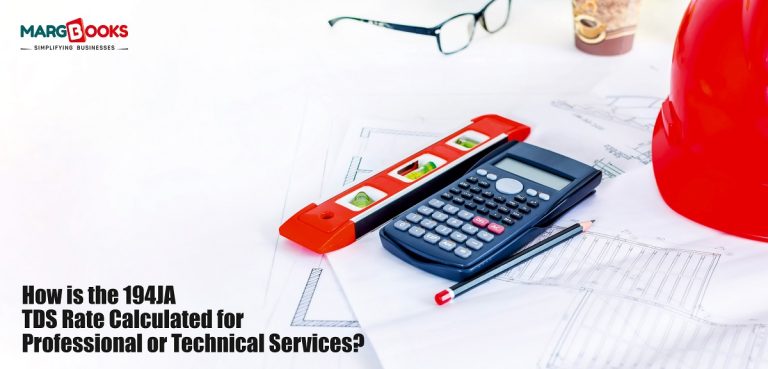When it comes to managing finances in a business, especially for professionals and technical service providers, understanding tax implications is crucial. One such important aspect is the 194JA TDS rate, which often leaves many taxpayers scratching their heads.
Let’s simplify it. In this blog, we’ll walk you through how the 194JA TDS rate is calculated, when it applies, who needs to deduct it, and why staying compliant is essential, especially when using tools such as online inventory software or billing software, MargBooks.
What Is Section 194JA?
To begin with, Section 194J of the Income Tax Act mandates that tax be deducted at source (TDS) when payments are made for professional or technical services. In 2020, the government split this section into two categories:
- 194J (a) – for professional services
- 194J (b) – for technical services (now known as 194JA)
This blog focuses on the 194JA TDS rate, which applies when payments are made to resident individuals or companies for technical services (not professional services).
What Exactly Are “Technical Services”?
In simple words, technical services include services that require specialised knowledge, such as:
- Software development
- IT consulting
- Engineering services
- Technical analysis or design
- Scientific or industrial consultancy
If your business uses such services even occasionally, there’s a high chance that TDS under section 194JA is applicable.
194JA TDS Rate: The Numbers
Let’s come to the heart of the matter: how much tax needs to be deducted under this section?
- TDS rate under 194JA: 2%
- Applicable threshold: ₹30,000 per financial year per payee
This means that if the total payment to a single service provider exceeds ₹30,000 in a financial year, you’re required to deduct 2% TDS on the entire amount.
Example:
Imagine you run a startup and hire an IT consultant for backend system development. You pay them ₹50,000 in total during the year.
Here’s how the TDS would be calculated:
- Amount paid = ₹50,000
- Since it’s above ₹30,000, TDS is applicable
- TDS = 2% of ₹50,000 = ₹1,000
So, you’ll pay the consultant ₹49,000 and deposit ₹1,000 to the government as TDS.
When to Deduct TDS under 194JA?
The timing is important:
- At the time of crediting the payment to the consultant’s account, or
- At the time of actual payment, whichever is earlier.
So even if the payment hasn’t been made but is recorded in your books, the TDS should be deducted at that point.
How to Stay Compliant?
Handling TDS manually can be time-consuming and prone to errors. That’s where modern solutions, MargBooks, an advanced billing software with integrated online inventory software features, come in handy.
With MargBooks, businesses can:
- Automatically detect transactions that fall under 194JA
- Calculate TDS correctly as per the applicable rate
- Generate TDS reports and challans
- Ensure timely payment to the government
- Maintain a clear audit trail
By combining billing and inventory management in a single platform, MargBooks makes it easy for businesses to remain compliant with tax regulations without extra burden.
Who Should Deduct TDS under 194JA?
Not everyone is required to deduct TDS under this section. Here’s a quick checklist of who must comply:
- Companies
- Partnership firms
- Sole proprietors (if subject to tax audit under Section 44AB)
- LLPs
- Government bodies
- Trusts
If you’re a small business or freelancer not covered under a tax audit, you’re generally not required to deduct TDS. But it’s always a good idea to consult with a tax advisor.
Consequences of Non-Compliance
Failing to deduct or deposit TDS can lead to several penalties:
- Interest on the amount not deducted or deposited
- Disallowance of expenses under Section 40(a)(ia)
- Late fees and penalties under Section 234E and 271H
Besides, it can hurt your reputation with vendors and consultants, especially if TDS issues delay their tax refunds.
Final Thoughts
Understanding and managing the 194ja TDS rate is not just about compliance it’s about running your business smoothly and professionally. Whether you’re paying for a one-time technical service or regularly hiring IT consultants, getting your TDS right can save you from a lot of trouble down the road.
By using reliable tools like MargBooks, which not only serves as an intuitive billing software but also functions as a powerful online inventory software, businesses can automate TDS calculations and focus more on growth rather than paperwork.
Quick Recap
- TDS under 194JA is 2% for technical services
- Applicable if annual payment exceeds ₹30,000
- Deduct TDS at credit or payment time, whichever is earlier
- Use smart tools like MargBooks for accuracy and compliance
Managing taxes doesn’t have to be complicated. With the right knowledge and the right tools, you’re all set.




